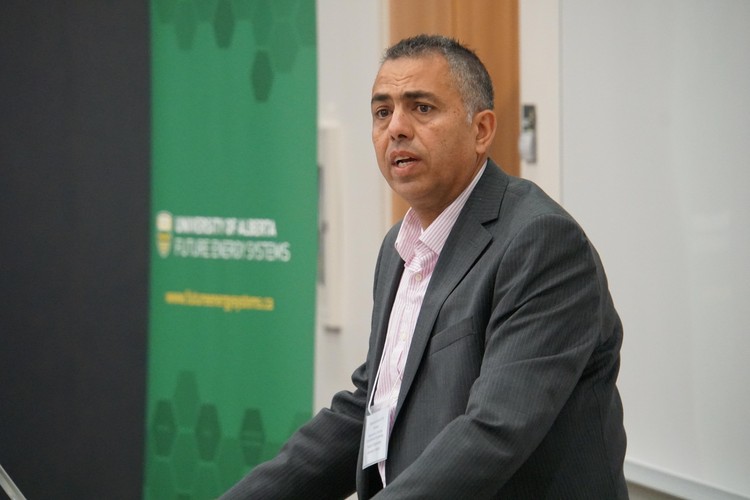Designing Practical Solutions for Tailings Ponds
Posted on
Dr. Mohamed Gamal El-Din is the 2017 winner of the Alberta Science and Technology Leadership (ASTech) Foundation award for Innovation in Oil Sands Research.
Mohamed Gamal El-Din receives 2017 ASTech award for work on active and passive water reclamation systems
Future Energy Systems Land and Water co-lead Mohamed Gamal El-Din has won the 2017 Alberta Science and Technology Leadership (ASTech) Foundation award for Innovation in Oil Sands Research. Announced last month, the award recognizes Gamal El-Din’s years of work developing innovative methods to reclaim oil sands process-affected water.
Freeing water from tailings
Water used in oil sands extraction process can be contaminated with a variety of particles, including heavy metals and organic compounds. To avoid damaging the surrounding environment, these waters are currently contained in more than 220 square kilometers of tailing ponds –– but eventually that water needs to go somewhere.
Making process water safe to release back into the environment has been Gamal El-Din’s priority for more than a decade. After beginning his career in municipal wastewater treatment, he recognized the eminent environmental challenge presented by oil sands extraction and began looking for solutions.
His work is paying off. Holding an NSERC Senior Industrial Research Chair at the University of Alberta, he has already done extensive work with oil sands companies to reduce the levels of contamination in their process water, but tailings ponds remain a constant feature.
“It will take few years before we can make tailings water safe for the environment,” he says. “But we will be able to make that happen.”
Active versus passive solutions
Technology currently exists that can remove the contaminants from oil sands process water, but these sorts of ‘active’ solutions tend to be energy-intensive and costly.
“Some people use membrane filtration systems to purify tap water at home,” Gamal El-Din explains. “This kind of technology could work for tailings water, but implementing it across hundreds of square kilometers would be impractical.”
Gamal El-Din therefore develops both ‘active’ and ‘engineered passive’ solutions that can scale up to meet the challenge. Purely active systems involve adding materials to contaminated water that gradually purify it over time, while engineered passive systems use the same approach but involve artificial system designs to simulate natural environments to facilitate the cleaning process.
He says constructing a special wetland with specific characteristics and capabilities could be an example of engineered passive solution.
These processes are not quick, but they can be very effective in purifying water. However, no two tailings ponds are identical, and standards have yet to be established to determine when water is safe to released.
Developing techniques and standards
As a co-lead in the Future Energy Systems Land and Water theme, Gamal El-Din is working with Anne Naeth and Dev Jennings on a large-scale multidisciplinary project that considers both the technical and societal aspects of land and water reclamation.
One aspect of the project involves further developing both active and engineered passive solutions that can be used in water reclamation systems. Another part focuses on setting standards and criteria for reclamation.
“We need to scientifically define the parameters that determine when water can safely re-enter the ecosystem, so that we can work to meet those criteria,” he explains. “There are metrics for municipal wastewater, but not tailings water –– because it has never been released back into the environment.”
Developing those standards, and continuing to work on solutions to meet them, remains Gamal El-Din’s focus. His leadership in water reclamation –– recognized by his 2017 ASTech award –– is an essential component of Future Energy Systems’ effort to mitigate the impacts of existing energy technologies.